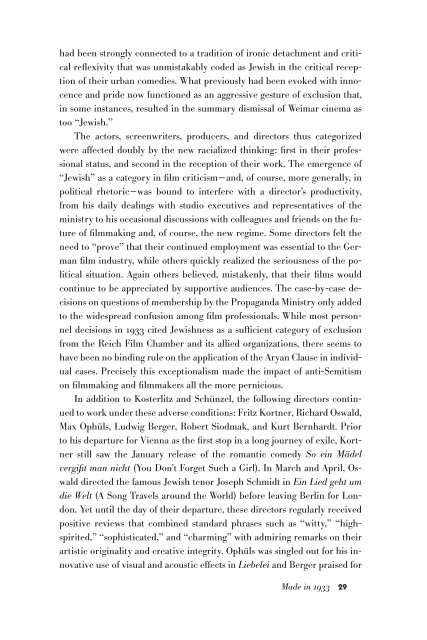You also want an ePaper? Increase the reach of your titles
YUMPU automatically turns print PDFs into web optimized ePapers that Google loves.
had been strongly connected to a tradition of ironic detachment and critical<br />
reflexivity that was unmistakably coded as Jewish in the critical reception<br />
of their urban comedies. What previously had been evoked with innocence<br />
and pride now functioned as an aggressive gesture of exclusion that,<br />
in some instances, resulted in the summary dismissal of Weimar cinema as<br />
too “Jewish.”<br />
The actors, screenwriters, producers, and directors thus categorized<br />
were affected doubly by the new racialized thinking: first in their professional<br />
status, and second in the reception of their work. The emergence of<br />
“Jewish” as a category in film criticism—and, of course, more generally, in<br />
political rhetoric—was bound to interfere with a director’s productivity,<br />
from his daily dealings with studio executives and representatives of the<br />
ministry to his occasional discussions with colleagues and friends on the future<br />
of filmmaking and, of course, the new regime. Some directors felt the<br />
need to “prove” that their continued employment was essential to the German<br />
film industry, while others quickly realized the seriousness of the political<br />
situation. Again others believed, mistakenly, that their films would<br />
continue to be appreciated by supportive audiences. The case-by-case decisions<br />
on questions of membership by the Propaganda Ministry only added<br />
to the widespread confusion among film professionals. While most personnel<br />
decisions in 1933 cited Jewishness as a sufficient category of exclusion<br />
from the Reich Film Chamber and its allied organizations, there seems to<br />
have been no binding rule on the application of the Aryan Clause in individual<br />
cases. Precisely this exceptionalism made the impact of anti-Semitism<br />
on filmmaking and filmmakers all the more pernicious.<br />
In addition to Kosterlitz and Schünzel, the following directors continued<br />
to work under these adverse conditions: Fritz Kortner, Richard Oswald,<br />
Max Ophüls, Ludwig Berger, Robert Siodmak, and Kurt Bernhardt. Prior<br />
to his departure for Vienna as the first stop in a long journey of exile, Kortner<br />
still saw the January release of the romantic comedy So ein Mädel<br />
vergißt man nicht (You Don’t Forget Such a Girl). In March and April, Oswald<br />
directed the famous Jewish tenor Joseph Schmidt in Ein Lied geht um<br />
die Welt (A Song Travels around the World) before leaving Berlin for London.<br />
Yet until the day of their departure, these directors regularly received<br />
positive reviews that combined standard phrases such as “witty,” “highspirited,”<br />
“sophisticated,” and “charming” with admiring remarks on their<br />
artistic originality and creative integrity. Ophüls was singled out for his innovative<br />
use of visual and acoustic effects in Liebelei and Berger praised for<br />
Made in 1933 29

















